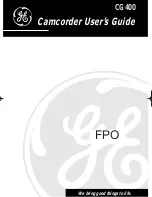
7
Precautions for use
DON’TS
p
Do not attempt to disassemble the camera or other units.
In order to prevent electric shock, do not remove screws
or covers. There are no user-serviceable parts inside.
p
Do not abuse the camera. Avoid striking, shaking, etc.
The camera contains sensitive components which could
be damaged by improper handling or storage.
p
Do not let the lens remain uncapped when the camera is
not use. If the lens is not installed, do not leave the lens
mount hole uncovered.
p
Do not touch the surface of the lens or prism.
p
Do not use strong of abrasive detergents when cleaning
the camera body.
p
Do not point the camera directly at the sun or a laser
beam no matter whether it is turned on or not.
Taking images of the sun, laser beams, or other brightly
lit subjects for prolonged periods of time may damage the
CCD.
p
Do not operate the camera outdoors during a lightning
storm.
p
Do not use the camera in an extreme environment where
high temperatures or high humidity exist.
p
Do not leave the camera turned on when not in use.
Do not unnecessarily turn the camera power on and off
repeatedly.
Do not block the ventilation slots.
p
Do not cover the port otherwise block ventilation during
operation. Internal heat buildup can cause a fire.
DO’S
p
Connecting to a CCU
Connect this unit to a designated CCU that is properly
grounded.
p
Refer any servicing to qualified service personnel.
p
Handle the camera with care.
p
Protect the precision made lens by placing the lens cap
over when the camera is not in use. If the lens is not
installed, protect the surface of the prism by placing the
body cap into the lens mount hole.
p
Use a mild blower or lens cleaning tissue designed for
coated lenses, to clean the surface of the lens or prism in
the event that it should become dirty.
p
Use a dry cloth to clean the camera if it is dirty. In case
the dirt is hard to remove, use mild detergent and wipe
gently.
p
Use caution when operating the camera in the vicinity
of spot lights or bright lights, as well as light reflecting
objects and surfaces.
p
Take immediate action if ever the camera should become
wet. Turn the power off and have the unit checked by an
authorized service facility.
p
Follow normal safety precaution to avoid personal injury.
p
Use the camera in an environment where the temperature
is within –10 °C to 45 °C, and the relative humidity is less
than 85 % (no condensation).
p
Always turn the power off when the camera is not going
to be used. Operate the camera only when there is
adequate ventilation.
p
Optical fibre connector
The transmission and reception conditions of optical
signals will deteriorate when the optical fibre connector
has become dirty so be sure to clean the connector.
p
Cooling fan
There is internally provided a cooling fan.
Since the cooling fan is a consumable part, replace it
after about 50,000 hours of operation.
(Be sure to ask the dealer for the replacement.)
p
When using the unit in windy or snowy conditions or at
the beach or at the waterfront, cover it with the rain cover
(optional accessory) or protect it in some other way in
order to prevent it from getting wet and stop water from
seeping inside.
p
Use the camera in places with minimal moisture and dust.
Avoid using the camera in places with high
concentrations of moisture or dust since these conditions
will tend to cause damage to the internal parts.
In addition, ensure that the connectors which are not in
use are covered with their protective caps.
p
Peripheral equipment software
The versions of the software used for the peripheral units
(such as the CCU, ROP and MSU) connected to the
AK-HC3500AE/ES may need to be updated.
For further details, contact your dealer.
p
A coin type battery is installed inside of the unit.
Do not expose the unit to excessive heat such as
sunshine, fire or the like.
Summary of Contents for AK-HC3500AES
Page 8: ...8 Controls and their functions...
Page 9: ...9 Controls and their functions...
Page 44: ...44 External dimension drawings Unit mm 360 260 105 135...
Page 47: ...47 Memo...








































